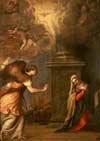 Filippo di Tommaso Lippi was born in Florence in about 1406. He took his vows in 1419 in the Monastery of Carmine. His training comes from studying Masaccio’s statuesque pictures and the use of colours and light made by Masolino.His first documented work is dated 1432: it is the fresco showing the confirmation of the Carmelitan order, painted in the cloister of the Chiesa del Carmine in Florence. Nothing is known about his painting before that date. The influence of Masolino and of Masaccio is evident in the Madonna of Humility in the Museum of the Sforza Castle in Milan. In thispainting the search for plasticism is enriched with what the painter learnt form contemporary artists such as Donatello. This make the shapes look wider and expands the surface of the volumes.
Filippo di Tommaso Lippi was born in Florence in about 1406. He took his vows in 1419 in the Monastery of Carmine. His training comes from studying Masaccio’s statuesque pictures and the use of colours and light made by Masolino.His first documented work is dated 1432: it is the fresco showing the confirmation of the Carmelitan order, painted in the cloister of the Chiesa del Carmine in Florence. Nothing is known about his painting before that date. The influence of Masolino and of Masaccio is evident in the Madonna of Humility in the Museum of the Sforza Castle in Milan. In thispainting the search for plasticism is enriched with what the painter learnt form contemporary artists such as Donatello. This make the shapes look wider and expands the surface of the volumes.
The artist was briefly in Padua, before painting the Madonna of Corneto Tarquinia (1437, now in the National Gallery of Palazzo Barberini in Rome). Flemish elements can be seen in this painting (the artist probably learnt about Flemish techniques during his stay in Padova). The solemn and imposing figures typical of Masaccio are replaced by fluid lines and volumes which let the observer catch a glimpse of the inner feelings of the characters in the picture.
In 1437 he received a commission for the Barbadori altarpiece in the Church of St Spirito (now in the Louvre, Paris). In this painting every space is filled with figures which create movement with their highly defined drapings. The clothes and expressions of each figure are carefully drawn.
every space is filled with figures which create movement with their highly defined drapings. The clothes and expressions of each figure are carefully drawn.
The artist’s later works were influenced by Beato Angelico and Domenico Veneziano. Their influence can be seen in the frescos of the Lives of St John the Baptist and Stephen in the Duomo of Prato, painted in 1452 and 1464. There are buildings in the background and the figures are static; expressions and posture are carefully studied. In this period he painted many other pictures (Madonna del ceppo, the Adoration of the Child, the Annunciation, the Madonna and angels). Filippo Lippi’s last works were the frescos in the chorus of the Duomo of Spoleto.
The artist died in Spoleto in 1469.